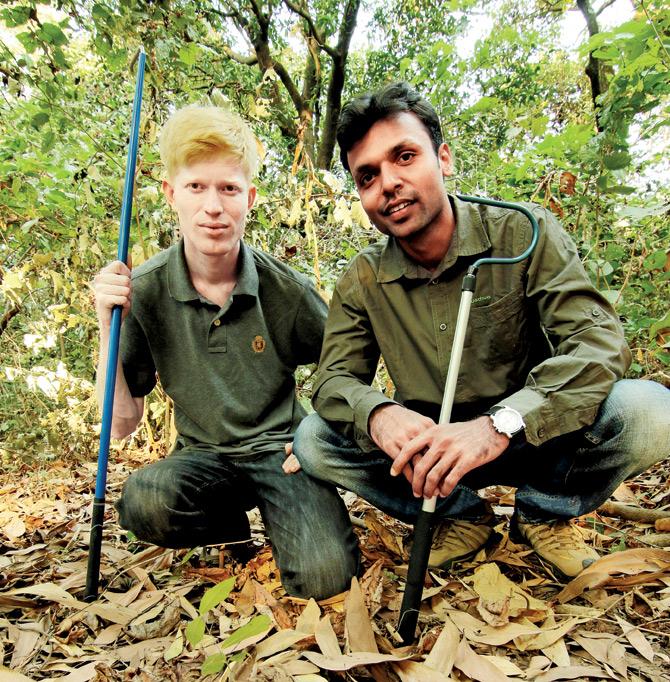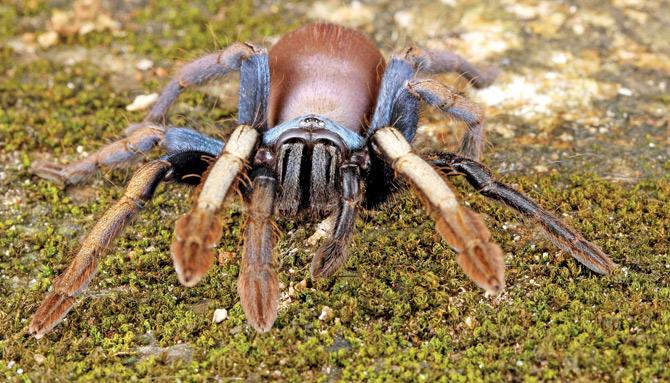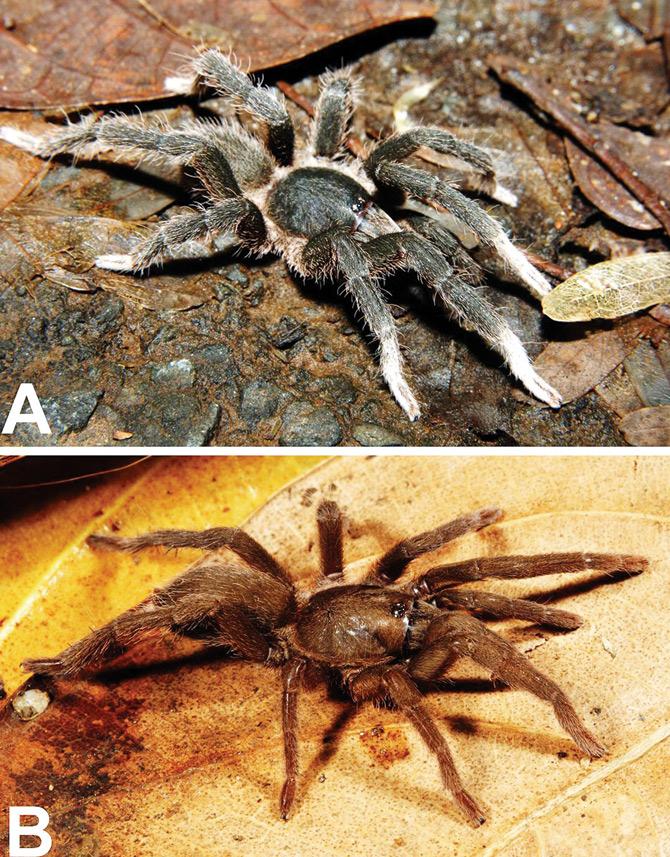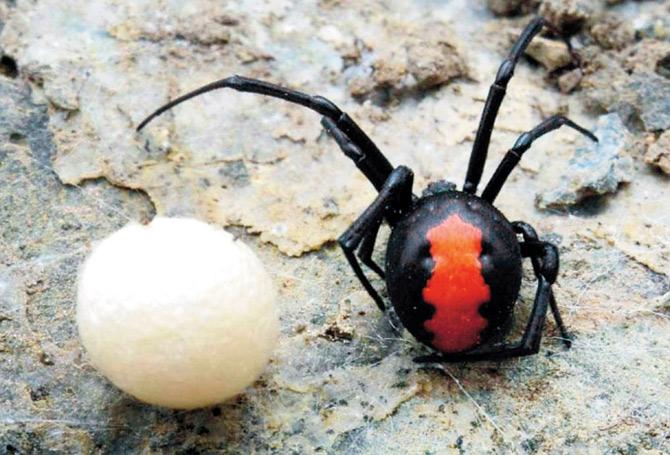Four new spider species discovered in Aarey in two years, thanks to social media, molecular research and stereomicroscopes fitted with DSLRs

The Heterophrictus aareyensis
If you thought tarantulas were the stuff that Hollywood horror flicks are spun of, then wildlife researchers Zeeshan Mirza and Rajesh Sanap will tell you these hide right in your backyard. Between June and October, in 2009, the Marol boys were surveying Goregaon’s Aarey Milk Colony, when they spotted a shallow burrow under a rotting log in the premises of a private estate. Hinged to the burrow was a D-shaped door made of a thin layer of cobwebs. Inside sat a female Haplocastus validus, measuring almost three centimeters.
ADVERTISEMENT

Zeeshan Mirza and Rajesh Sanap discovered the Thrigmopoeus psychedelicus in Kerala
The creature is commonly called the robust trapdoor tarantula, and is a not-so-common find. The robust trapdoor spider was last chanced upon in 1899 by men laying railway tracks in Matheran. A specimen was sent to British zoologist Reginald Innes Pocock, who worked at London’s Museum of Natural History. That was the last it was heard of. The “re-discovery” of the mega-spider by 28-year-olds Mirza and Sanap, who now research at Bengaluru’s National Centre for Biological Sciences, was an important turn in the nation’s arachnid research.

The Heterophrictus aareyensis was named after Aarey Colony, where it was discovered
In the last one year, 176 species of animals have been discovered across India, reports the Zoological Survey of India. In Mumbai, four new species of spiders have been discovered in the last two years, just when you thought this concrete jungle had nothing more to offer. And, the resurgence in Indian research has come with technology, connectivity and conservation.
“People think taxonomy is not a science, but the art of comparison. Today, taxonomy is coupled with hard science,” says Mirza. Pocock’s taxonomical descriptions were about five sentences long, with hand-drawn diagrams. The average description, these days, is about six pages long, replete with hi-resolution images made under high-zoom stereomicroscopes, with maps and statistics. It’s trendy, and necessary, to be a taxonomist these days.

Europe is just a click away
Professor Hemant Ghate, retired from Pune’s Modern College three years ago, has worked in the field for 40 years. The zoologist says the major change has come with computers and the Internet, which has given researchers access to specimens in the form of digitized archives. The two things that are crucial for taxonomy, he says, are specimens and literature.

His co-researcher, 24-year-old Siddharth Kulkarni, says, “Back then, literature used to come by ship. Now, it’s just a click away. Many Indian specimens collected by European zoologists are housed in museums abroad. It’s great that these institutions have opened up their digital repository.”
Kulkarni is a coordinator for the website World Spider Catalog, which gives access to some of the earliest publications on arachnids dating to the mid 1700s. The hitch in India’s tryst with taxonomy, he says, is its relatively recent entry into the world of species-finding and categorisation, as work by Indians has taken off mostly post-Independence. Rahul Khot, curator for the Bombay Natural History Society (BNHS), says, “With advancement in technology, researchers are able to correct misidentified species, solve some mysteries and understand India’s natural diversity.”

In 2009, Siddharth Kulkarni posted a picture of an Indian black widow on Orkut (above centre), different from its Australian counterpart
Social media to the rescue
The digitizing of specimens and descriptions is an important step to the democratisation of scientific information. And, it need not always be in the manner of academic volumes. A free Android app, called Frog Find, is an extension of a well-known book by batrachologist Dr Gururaja KV. Mirza runs a Facebook page called Scorpions of India and is developing a scorpion-locating app. The BNHS will soon digitise its collection of 1,20,000 specimens of Indian fauna, of which 400 are arachnids, for public access.
Then, there are the things that people frivolously share — a funny video of the mating ritual of jumping spiders that looks like a flamenco dance movement. “Apps and social media help us talk to each other about sightings. These conversations are important in a country with diverse species. It is easy for people to think they have spotted a new species and, conversely, to miss out on a new one,” says Mirza.

Rahul Khot
Kulkarni will vouch for this. In 2009, he had found a rather curious spider, with a red stripe running across its abdomen, in Lonand, Satara district. He posted a photograph of the unusual spider on Orkut and was astounded to hear from an Australian on the social network that it looked like a black widow from his continent.
The DNA name
Kulkarni studied the Indian black widow at the Naturalis Biodiversity Centre in the Netherlands, and observed that its stripe is structurally different from that of its Australian counterpart. Research is on to confirm if it’s a new specie. It’s currently known only by its genus name — Latrodectus. However, Prof Ghate says, “We name our insects just like we name our children. Once the DNA barcoding has been done for a specie, even finding just the leg of a spider is now enough to understand its DNA and ascertain if it's a new specie or not.” Molecular sequencing, which when coupled with classical taxonomy, transforms the art into a science.
Spidey saves the day
Through a researchers networking group, Kulkarni was introduced to members of the Thomisidae family at Kaas plateau. Their specialty — mimicking the flowers they inhabit and ambushing unaware prey. “Flower spiders have camouflaging techniques and look beautiful. They draw a lot of funding, just like butterflies,” he says.
The Renaissance in Indian arachnid taxonomy is more than just about the fancy tech. “New discoveries are the result of conservation action. Researchers are actively seeking out endangered species and garnering funding to further their studies,” says Khot. The data collected from Aarey, he says, can change the conversation about the space and stop devastating infrastructure projects in that area. A little spider, it seems, can just be what Aarey needs.
 Subscribe today by clicking the link and stay updated with the latest news!" Click here!
Subscribe today by clicking the link and stay updated with the latest news!" Click here!








